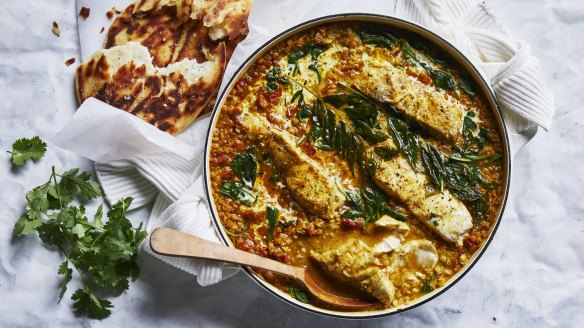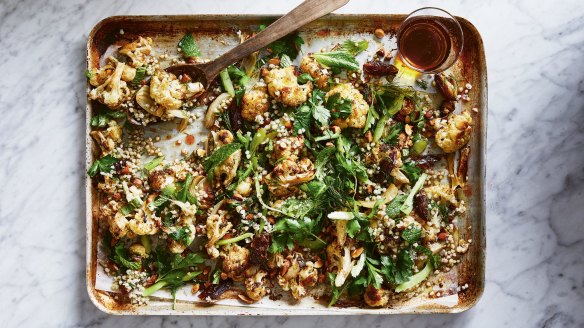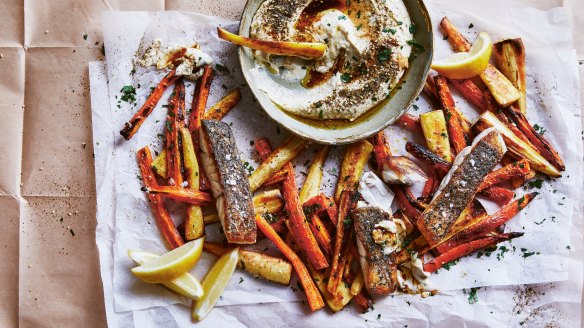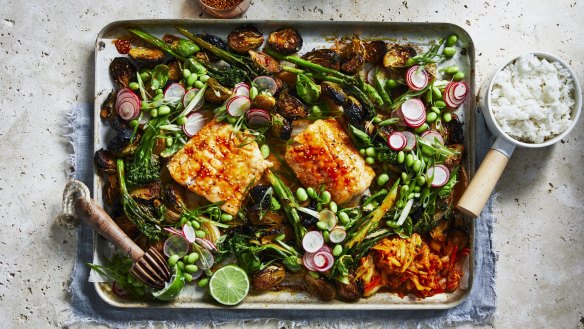Four fresh fish and veg recipes to boost your cooking confidence

Some people are nervous about cooking fish. Talk about under- or overcooking it can make cooking seafood sound like an exact science, which is so far from the truth.
My advice is not to shy away from cooking fresh fish; it all starts with great ingredients and, ideally, try to use sustainable, locally sourced seafood.
Red lentil and coconut dhal with fish
Dhal has to be one of my all-time favourite dishes. I love to top it with roast vegies or seafood to make it even heartier. Feel free to cook the dhal and fish separately and serve them as part of a larger spread. For a plant-based version, serve it with some roasted cauliflower or eggplant instead of fish.
INGREDIENTS
- 80ml (⅓ cup) coconut oil
- 4 sprigs fresh curry leaves
- sea salt flakes and ground black pepper
- 1 brown onion, finely chopped
- 2 garlic cloves, crushed
- 3cm piece ginger, peeled and finely chopped
- 2 tbsp curry powder, plus 2 tsp extra
- 2 tomatoes, finely chopped, or 2 tbsp tomato paste (concentrated puree)
- 410g (2 cups) split red lentils
- 1½ litres (6 cups) chicken or vegetable stock
- 400ml can coconut milk
- 2 large handfuls roughly chopped kale or baby spinach leaves
- 400g Spanish mackerel fillet, skin removed, or any other firm white-fleshed fish, such as ling or blue-eye trevalla
- 2 tbsp olive oil
- 2 handfuls coriander leaves
- steamed basmati rice or naan bread, to serve (optional)
METHOD
- Heat the coconut oil in a large shallow ovenproof frying pan over medium-high heat. Add half the curry leaves and cook for about 2 minutes, until crisp and translucent. Transfer to a plate, lightly season with salt and set aside.
- Add the onion, garlic and a good pinch of salt to the coconut oil and cook, stirring, for 4-5 minutes. Add the ginger, the remaining curry leaves, the 2 tablespoons of curry powder and the tomatoes and cook for 1 more minute, then add the lentils and stir through.
- Pour the stock into the pan and cook over low heat for 20 minutes, until the lentils are cooked and creamy. Tip in three-quarters of the coconut milk and cook for 2 minutes, then add the kale or spinach and stir through until wilted.
- Preheat the oven to 180C fan-forced (200C conventional).
- In a shallow bowl, combine the fish with the extra curry powder, some salt, pepper and the olive oil, until coated. Nestle the fish in the dhal, transfer to the oven and bake for 10 minutes, until just cooked.
- Remove the dhal from the oven, scatter with the coriander leaves and drizzle with the remaining coconut milk. Top with the fried curry leaves and serve with the steamed rice or naan, if desired.
Serves 4

Caramelised cauliflower salad with dates, almonds and buckwheat
Roast cauliflower is probably my favourite salad staple. Swap the buckwheat for any other grain, brown rice or lentils, and switch dates with sultanas, cranberries, diced apple or pomegranate, if you like. This salad can be made up to 2 hours ahead of time and refrigerated without the dressing.
INGREDIENTS
- 1 small cauliflower, cut into florets
- 1 brown onion, cut into thick wedges
- 1 tsp ground cumin seeds
- 1 tsp ground coriander seeds
- 80ml (⅓ cup) olive oil
- sea salt flakes and ground black pepper
- 195g (1 cup) buckwheat, soaked overnight and drained
- 8 fresh dates, roughly torn
- 40g (¼ cup) toasted almonds, roughly chopped
- 3 celery sticks, thinly sliced
- handful flat-leaf parsley leaves
- handful mint leaves
- handful dill sprigs
- 2 tbsp extra virgin olive oil
- 1 tbsp red wine vinegar
METHOD
- Preheat the oven to 200C fan-forced (220C conventional) and line a baking tray with baking paper.
- Bring a saucepan of water to the boil.
- Meanwhile, toss the cauliflower and onion in a bowl with the spices, olive oil and some salt and pepper. Scatter on the tray and roast for around 15 minutes, until charred and tender. Set aside.
- Rinse the buckwheat well, then drain it again. Blanch it in the boiling water for 4 minutes, then refresh under cold running water and drain it well again. Place it in a bowl with the roasted cauliflower and onion, the dates, almonds, celery and herbs.
- Dress the salad with the extra virgin olive oil, vinegar and some salt and pepper, and gently toss to combine before serving.
Serves 4

Crispy-skin fish and vegie chips with garlicky butter bean dip
This is a light, tasty riff on the classic fish and chips. If you don't want to pan-fry the fish, feel free to bake it – just choose a fish without skin, lightly oil and season it, then bake in the oven for around 7 minutes. You could also leave out the fish and serve the fries as a stellar snack or side.
INGREDIENTS
- 4 x 150g firm-fleshed fish fillets, such as barramundi, blue-eye trevalla, Spanish mackerel, ling or NZ king salmon
- 6 carrots, peeled and cut into quarters
- 4 large parsnips, peeled, cut into quarters and cores removed
- 80ml (⅓ cup) olive oil
- sea salt flakes and ground black pepper
- 1 tablespoon zaatar
- handful flat-leaf parsley leaves, finely chopped
- ½ lemon, cut into wedges, to serve
Garlicky butter bean dip
- 400g can butter beans, rinsed and drained
- 1 garlic clove
- 2 tbsp olive oil, plus extra to drizzle
- 65g (¼ cup) hulled tahini
- juice of ½ lemon
METHOD
- Place the fish fillets on a board, skin-side up. Gently run the back of a knife down the fish's skin to release any moisture, then pat it dry with paper towel. If you have time, let the fish sit in the fridge, uncovered and skin-side up, for at least 2 hours to further dry out.
- Preheat the oven to 200C fan-forced (220C) and line a large baking tray with baking paper.
- Combine the carrots and parsnips in a bowl and drizzle with 2 tablespoons of the olive oil, then season with a little salt and pepper. Scatter them onto the tray in a single layer and roast for 20-25 minutes, until they are charred and just cooked.
- Meanwhile, make the garlicky butter bean dip by combining all the ingredients in a blender with 80ml (⅓ cup) water and blending into a smooth puree. Adjust the seasoning to taste with salt and pepper, then pour into a small serving bowl and top with half the zaatar and drizzle with the extra olive oil.
- Season both sides of the fish with a little salt. Heat a non-stick frypan over medium-high heat. Add the remaining olive oil, then carefully add the fish, skin-side down. Season the flesh with pepper, then firmly press down on the fish with the back of a spatula for 10-20 seconds. Cover with a lid, reduce the heat to medium and cook for a further 3-4 minutes. This allows the flesh to cook gently and the skin to become very crisp. Keep a close eye on the fish, as the cooking time may vary slightly, depending on its thickness.
- Turn off the heat, flip the fish over and let it rest in the pan for 1-2 minutes. Transfer to a plate and keep warm.
- Scatter the parsley and remaining zaatar over the vegie fries and serve them with the garlicky butter bean dip, crispy-skin fish and the lemon wedges to squeeze over.
Serves 4

Gochujang fish and Brussels sprouts tray bake
Brussels sprouts work so well in this dish, but feel free to mix it up with other seasonal vegies like cauliflower, broccoli, pumpkin, eggplant or zucchini, cut into similar-sized pieces. Serve this with steamed rice or grains, or throw some diced sweet potato onto the tray before roasting.
INGREDIENTS
- 650g blue-eye trevalla or ling fillet, skin on
- 500g Brussels sprouts, cut in half
- 1 brown onion, cut into thin wedges
- 1 bunch broccolini
- sea salt flakes
- 2 tbsp olive oil
- 250ml (1 cup) gochujang dressing (see recipe below)
- 4 radishes, thinly sliced
- 3 spring onions, thinly sliced
- 75g (½ cup) edamame beans
- 1 tbsp rice vinegar
- 1 tbsp sesame oil
- 100g (½ cup) kimchi, to serve (optional)
- steamed rice, to serve
METHOD
- Preheat the oven to 210C fan-forced (230C conventional).
- Place the fish in a shallow bowl. Place the Brussels sprouts and onion in a second bowl and the broccolini in a third bowl. Season them all with a little salt, drizzle with the olive oil and divide the gochujang dressing between the three bowls, reserving 60ml (¼ cup) of the dressing for serving. Gently toss all the ingredients together in their separate bowls to coat them.
- Scatter the Brussels sprouts, onion and any remaining marinade onto a large baking tray lined with baking paper and roast for 7 minutes. Remove from the oven and add the fish, skin-side down, the broccolini and all the marinade from the bowls. Roast for 8 minutes, until the fish is just cooked and the vegies are a little charred and gnarly.
- Meanwhile, combine the radish, spring onion and edamame with the rice vinegar, sesame oil and a little salt. Scatter this over the fish and vegies and serve with the kimchi, the reserved gochujang dressing and the steamed rice.
Gochujang dressing
Gochujang is on high rotation in our kitchen. The fermented chilli paste is a pantry staple, and a key to creating deliciousness with whatever I have on hand. This dressing has the most amazing spicy, umami-rich flavour, making it the perfect marinade or glaze. Add this to soups, toss it through noodles or use it to marinate and dress prawns or squid. It's a delicious dipping sauce for sashimi, too. If you can't find gochujang, you can substitute with equal quantities of white miso and Sriracha combined together. For a milder version, you could just use miso on its own.
INGREDIENTS
- 60ml (¼ cup) gochujang (see Note)
- 2 tbsp soy sauce
- 2 tbsp sesame oil
- 2 tbsp rice vinegar
- 2 tbsp honey or maple syrup
- 2 tbsp toasted white sesame seeds
- 3cm piece ginger, finely grated (optional)
METHOD
- Combine the gochujang, soy sauce, sesame oil, vinegar, honey or maple syrup and sesame seeds in a bowl and stir to make a smooth sauce. Add the ginger (if using) and mix through. Transfer to an airtight container or jar and store in the fridge for up to 2 months.
Makes 250ml (1 cup)
Note Gochujang is a fermented rice-based chilli paste that is popular in Korean cooking. Find it in the Asian aisle of some supermarkets and at most Asian grocers.
Pro tip If you keep your gochujang in the fridge, bring it to room temperature before mixing it with other ingredients, otherwise it will be too hard.
This is an edited extract from More Fish, More Veg by Tom Walton, photography by Rob Palmer. Murdoch Books, RRP $39.99. Buy now